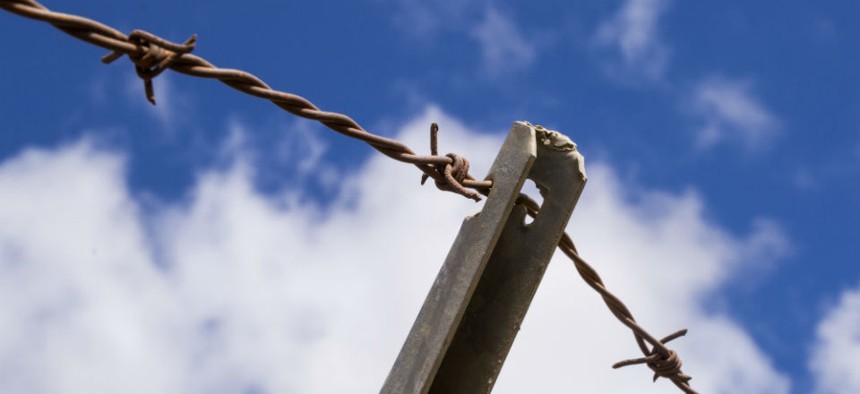
Eddie J. Rodriquez / Shutterstock.com
Here's What CIA Interrogators Are Still Allowed to Do
The CIA's enhanced interrogation techniques have been illegal since 2009, but interrogators are still permitted to use some controversial methods.
Although the CIA's brutal "enhanced interrogation techniques" have been illegal for almost five years, the rulebook its interrogators must now follow still allows it to use tactics some critics call torture.
The Senate report on the CIA's interrogation tactics released Tuesday describes a sweeping program that saw detainees subjected to harsh treatment in secret overseas prisons. But since 2009, the CIA has been constrained to following the U.S. Army's guidelines for interrogations. Here's a look at those regulations.
The Army Field Manual
The Army maintains a set of field manuals that outline everything from day-to-day military operations to survival techniques to the basic rules of war. One of these manuals coverstactics, strategy, and rules for Army interrogators. It specifically details 18 techniques approved for interrogators to use on their subjects, and lists forbidden methods.
The manual requires that detainees be dealt with "humanely," and prohibits "cruel, inhuman, or degrading treatment." It specifically forbids interrogations that involve placing hoods over detainees' heads, beatings and other forms of physical pain, forcing prisoners to perform sexual acts, and waterboarding. Interrogators may not humiliate detainees, threaten to revoke legally guaranteed protections if they don't cooperate, or even threaten to hand them over to someone else who may abuse them.
The manual echoes one of the main points of the Senate report: that the CIA's interrogation techniques didn't produce useful intelligence. "Use of torture is not only illegal," the Army manual reads, "but also it is a poor technique that yields unreliable results, may damage subsequent collection efforts, and can induce the source to say what he thinks the [interrogator] wants to hear."
If interrogators or monitors are worried that their tactics are approaching the line of illegality, the manual recommends they ask themselves two questions:
• "If the proposed approach technique were used by the enemy against one of your fellow soldiers, would you believe the soldier had been abused?
• Could your conduct in carrying out the proposed technique violate a law or regulation?"
In a separate section, the manual outlines approved approaches for interrogators. They range from the straightforward—the "direct approach," in which an interrogator simply asks a detainee for information, or the "incentive approach," where the interrogator gives the detainee something in return for information—to the emotionally manipulative and fear-inducing. But even when attempting to frighten a detainee, the field manual requires the interrogator to "be extremely careful that he does not threaten or coerce."
The Prison System That Almost Was
When the CIA was first cooking up plans for its network of overseas prisons, it intended to create a system where detainees were afforded the same rights and treated the same way as prisoners in the U.S., The New York Times reported Thursday. That system was to be modeled off American maximum-security prisons, and would have required interrogators to follow the Army field manual when questioning detainees.
But at the last minute, officials changed their minds. Instead of establishing American-style prisons abroad, they created a series of "black sites" where detainees were treated far more harshly than would be allowed in the U.S. This week's report described detainees who were kept in extreme conditions and subjected to sleep deprivation, rectal feeding and rehydration, and repeated waterboarding.
These tactics stopped in 2007, according to the CIA and the Senate report. Two years later, on his second day in office, President Obama signed an executive order that required all individuals in American custody to be treated in accordance with the conditions in the Army field manual.
What's Still Allowed?
Even though extreme tactics like waterboarding are forbidden—now even for the CIA—the U.S. still employs methods that some critics consider torture. One of the most-discussed examples is the continued practice of force-feeding detainees at the Guantanamo Bay prison who refuse to eat. A U.N. report recently called force-feeding hunger striking prisoners a violation of the U.N. Convention Against Torture. The practice is not covered in the Army field manual.
Equally controversial is a section of the manual called Appendix M, which the Bush administration added to the document in 2006. The appendix authorizes interrogators to hold detainees in isolation in order to "foster a feeling of futility." The idea behind isolation is that detainees who communicate with one another might be better at resisting interrogation. The section also requires that detainees be allowed a minimum of four hours of sleep every 24 hours, which allows for up to a 40-hour period of sleep deprivation.
The field manual says the practice can only be used on "unlawful enemy combatants," a distinction the CIA used for years to justify its treatment of detainees at its overseas black sites. Amnesty International says the methods outlined in the appendix violate the terms of the Geneva Conventions and other international agreements on torture.
It may be that the worst of the brutal CIA tactics described in the Senate report have been illegal for years, but the methods the CIA is still allowed to use continue to give critics fodder for questioning Obama's claim that he outlawed torture in the U.S.
(Image via Eddie J. Rodriquez / Shutterstock.com)







